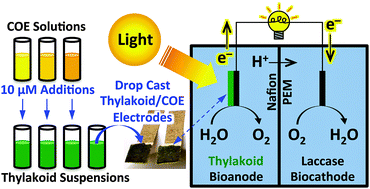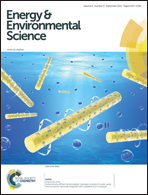The photobioelectrochemical activity of thylakoid bioanodes is increased via photocurrent generation and improved contacts by membrane-intercalating conjugated oligoelectrolytes†
Abstract
The photobioelectrochemical impact of a series of conjugated oligoelectrolytes (COEs) with a systematic progression of chemical structures was elucidated by their direct incorporation into thylakoid bioanodes. In both three-electrode electrochemical cells and bio-solar cell devices, significant anodic performance enhancements (p < 0.1) were observed when anodes were modified with certain COEs. Amperometric photocurrent densities increased by up to 2.3-fold for the best COE. In bio-solar cell devices, short-circuit photocurrent increased by up to 1.7-fold and short-circuit dark current increased by up to 1.4-fold, indicating that the best COEs enhance both photocurrent generation and interfacial electron transfer. Trends in these results indicate that the molecular length and pendant charge of COEs differentially contribute to photobioelectrochemical enhancements, and the optimal combination of these features is revealed. Control experiments indicate that COEs augment native thylakoid functionality, as COEs do not have redox activity or undergo chemical degradation.



 Please wait while we load your content...
Please wait while we load your content...